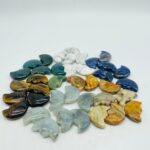Introduction: Unveiling the Allure of Elemental Crystals
Crystals, with their captivating beauty and intriguing properties, have long captivated the human imagination. These solid structures, characterized by their ordered atomic arrangement, exhibit a wide range of colors, shapes, and sizes. Throughout history, crystals have played a multifaceted role, adorning jewelry, inspiring spiritual practices, and facilitating scientific advancements.

Formation and Types: The Genesis of Crystal Diversity
Crystals originate from the solidification of molten rock or from the precipitation of minerals from aqueous solutions. The rate of cooling, the presence of impurities, and the surrounding environmental conditions influence the crystal’s ultimate size, shape, and structure.
Crystals are classified into various groups based on their chemical composition and crystallographic structure. Prominent examples include:
- Quartz: A versatile mineral with a hardness of 7 on the Mohs scale, making it resistant to scratching. Quartz comes in a wide variety of colors, including clear, pink (rose quartz), purple (amethyst), and smoky gray.
- Calcite: A common mineral with a hardness of 3 on the Mohs scale, giving it a softer and more fragile nature. Calcite is primarily composed of calcium carbonate and exhibits a wide range of colors, such as white, red, orange, and green.
- Gemstones: Prized for their beauty and rarity, gemstones are minerals that have been cut and polished for use in jewelry. Notable examples include diamond, ruby, sapphire, and emerald.
Crystal Properties: Exploring the Extraordinary
Crystals possess a spectrum of remarkable properties that have sparked scientific interest and practical applications.
Electrical Properties
- Piezoelectricity: Certain crystals, when subjected to mechanical stress, generate an electrical charge. This property finds use in sensors, transducers, and medical imaging devices.
- Pyroelectricity: A subset of crystals produce an electrical charge in response to temperature changes, enabling applications in infrared detectors and temperature sensors.
Thermal Properties
- Conductivity: The ability of crystals to transfer heat varies, with some being excellent conductors and others having low conductivity. This property is crucial in designing materials for heat sinks, electronic components, and thermal insulation.
Optical Properties
- Refraction: Crystals bend light as it passes through them, causing it to change direction. This phenomenon is harnessed in lenses, prisms, and optical fibers for image processing, communication, and spectroscopy.
- Reflection and Transmission: Crystals exhibit varying degrees of light reflection and transmission, giving rise to applications in mirrors, windows, and filters.
Applications: Unlocking the Potential of Crystals
The unique properties of crystals have led to their utilization in a myriad of industries, including:
- Electronics: Piezoelectric crystals are used in oscillators, filters, and sensors.
- Energy: Solar cells made of crystalline silicon harness the sun’s energy to generate electricity.
- Medical: Calcite crystals play a role in ultrasound imaging, providing high-resolution images of soft tissues.
- Jewelry: Gemstones are coveted for their aesthetic appeal and are extensively used in jewelry making.
- Industrial: Quartz crystals are employed in watches, timing devices, and laser technology.
Market Trends and Emerging Applications
The global crystal market has witnessed steady growth in recent years, driven by increasing demand from various industries. According to Allied Market Research, the market size for crystals was valued at around $51 billion in 2020 and is projected to reach $82 billion by 2030.
Emerging applications continue to fuel the demand for crystals, including:
- Nanotechnology: Crystals in nanometer scale offer enhanced properties for use in sensors, drug delivery systems, and energy storage devices.
- Quantum Computing: Synthetic diamond crystals have shown promising potential as quantum bits for future quantum computers.
- Medical Imaging: Scintillator crystals are crucial components in medical imaging devices, such as PET and SPECT scanners.
Tips and Tricks: Maximizing Crystal Benefits
- Identify the Right Crystal: Consider the specific properties and applications you require to choose the most suitable crystal.
- Cleanse and Charge Crystals: Regularly cleanse crystals to remove negative energy and charge them to enhance their effectiveness.
- Program Crystals: Hold the crystal in your hand and focus on your desired intentions to program it with specific energies.
- Meditate with Crystals: Place crystals on your body or in your surroundings during meditation to promote relaxation, healing, and spiritual growth.
Common Mistakes to Avoid: Pitfalls in Crystal Usage
- Overwhelming Yourself: Start with a few crystals and gradually add more as you become familiar with their properties.
- Neglecting Physical Care: Crystals can become dusty or chipped over time, so ensure you clean and handle them with care.
- Ascribing Magical Powers: While crystals possess unique properties, it is essential to rely on scientific evidence rather than attributing magical powers to them.
- Substituting Medical Care: Crystals can complement holistic practices, but never use them as a replacement for professional medical advice or treatment.
Conclusion: The Enduring Legacy of Element Crystal
Crystals, with their mesmerizing beauty and versatile properties, continue to fascinate and inspire. From ancient civilizations to modern-day applications, crystals have played a pivotal role in shaping our understanding of the natural world and advancing technological advancements. As we delve deeper into the world of crystals, we uncover new possibilities and applications, cementing their enduring legacy in shaping the future.
Tables: Providing Key Insights
Table 1: Classification of Crystals
| Crystal Type | Chemical Composition | Examples |
|---|---|---|
| Silicates | SiO2 | Quartz, Feldspar |
| Carbonates | CaCO3 | Calcite, Aragonite |
| Oxides | Fe2O3 | Hematite, Magnetite |
| Sulfides | FeS2 | Pyrite, Galena |
| Halides | NaCl | Halite, Fluorite |
Table 2: Physical Properties of Common Crystals
| Crystal | Hardness (Mohs Scale) | Density (g/cm3) |
|---|---|---|
| Diamond | 10 | 3.52 |
| Quartz | 7 | 2.65 |
| Calcite | 3 | 2.71 |
| Ruby | 9 | 4.00 |
| Sapphire | 9 | 4.03 |
Table 3: Electrical Properties of Crystals
| Crystal | Piezoelectric | Pyroelectric |
|---|---|---|
| Quartz | Yes | Yes |
| Calcite | No | Yes |
| Topaz | Yes | No |
| Tourmaline | Yes | Yes |
| Barium Titanate | Yes | Yes |
Table 4: Market Share of Crystals by Industry
| Industry | Market Share (%) |
|---|---|
| Electronics | 35 |
| Energy | 25 |
| Medical | 15 |
| Jewelry | 10 |
| Industrial | 15 |




























